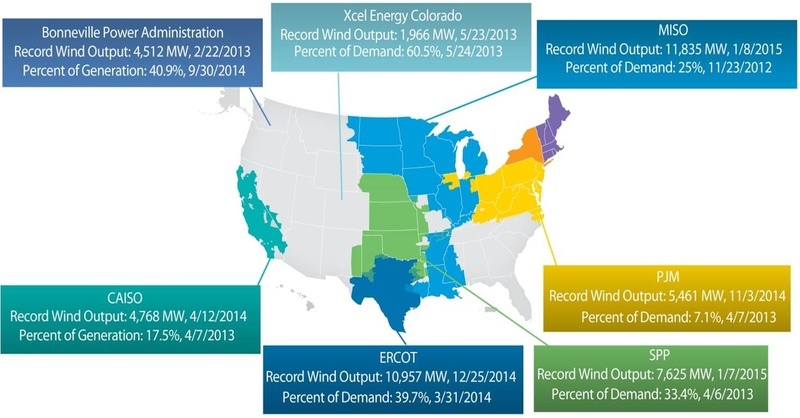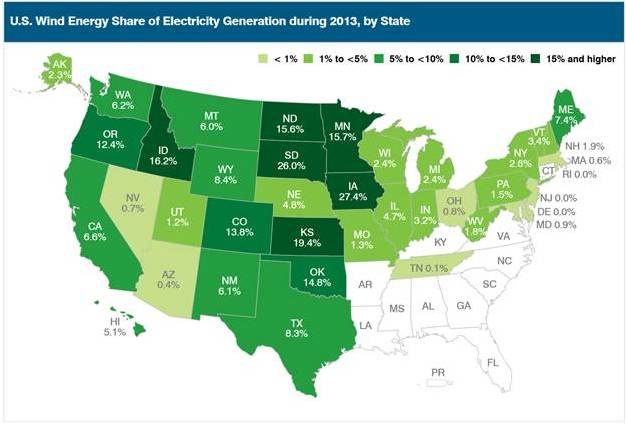News Release from American Clean Power Association (ACP)
Wind Industry Profile of
Report Excerpt - Wind power can help U.S. meet EPA Clean Power Plan while keeping the lights on
Adding wind power can help the U.S. meet the Environmental Protection Agency’s (EPA) Clean Power Plan by cutting carbon pollution while keeping the lights on. That’s according to a new report released today by the American Wind Energy Association (AWEA) that explains how wind energy is already making critical contributions to the reliable operation of the power system.
“Americans want energy security, clean air, and a more reliable energy system,” said AWEA CEO Tom Kiernan. “Diversifying our energy mix with wind helps us achieve all of these goals at once.”
The 15 most common questions about wind power and reliability are answered in AWEA’s report, “Wind energy helps build a more reliable and balanced electricity portfolio,” based on grid operators’ real-world experience integrating wind power as well as dozens of studies conducted by grid operators examining how higher levels of wind use can be achieved.
Wind energy has recently set a number output records
As wind energy has grown to provide a larger share of our electricity mix, wind turbine technology has matured so that modern wind plants are able to provide the same grid reliability services as conventional generators.
Changes in wind output are not a major issue for grid operators because all power plants are already backed up by all other power plants, and grid operators already deal with large fluctuations in electricity supply and demand. In fact, the gradual and predictable changes in wind power are also much easier for grid operators to address than the large-scale outages that can occur at conventional power plants.
“Based on grid operators’ experience with reliably and cost-effectively integrating very large amounts of wind energy, wind can play can play a key role in meeting EPA’s Clean Power Plan,” said AWEA Senior Director of Research Michael Goggin.

Past real-world examples presented in the report help illustrate wind’s role in keeping the lights on. Wind energy helped keep the lights on in Texas when fossil-fired power plants failed in the cold in February 2011, and more recently did so again across much of the U.S. during the “Polar Vortex” in early 2014.
Other highlights of the report include:
- Iowa and South Dakota reliably produce more than 25 percent of their electricity from wind power; nine states produce more than 12 percent and more than 4 percent in the U.S. overall.
- Technological advances have enabled U.S. wind farms to set generation records as a percent of demand over the past two years, all without reliability problems:
- At times more than 60 percent on Xcel Energy’s Colorado power system;
- Nearly 40 percent of generation in ERCOT, the main Texas power system; and
- 33 percent in the Southwest Power Pool (area that covers all or parts of several states in the Southwest
- The largest grid operator in the U.S., PJM, recently reported it could reach 30 percent of wind power while maintaining electricity reliability.
- Ireland, Spain, and Portugal obtaining around 20 percent of their electricity from wind on an annual basis, Denmark at nearly 35 percent, and Germany at 25 percent from wind and solar.
- More than a dozen wind integration studies by U.S. grid operators and others find wind energy can reliably supply at least 20-30 percent of U.S. electricity demands; some studies showing 40 percent.
- Wind power saved consumers $1 billion over just two days across the Great Lakes and Mid-Atlantic states during the 2014 “Polar Vortex” event.
- The current U.S. wind fleet will reduce CO2 emissions by 150 million short tons per year, the equivalent of reducing power sector emissions by more than 5 percent, or 28 million cars worth of carbon emissions.
- There’s enough wind power installed to provide electricity for the equivalent of 18 million American homes.

Last year, the EPA released its first-ever draft rules aimed at reducing carbon pollution at existing power plants. Continuing to add wind energy to the U.S. electricity mix can help comply with other parts of EPA’s plan, lessening the requirements on other parts of the electric sector.
AWEA will be testifying at FERC’s February 19 technical conference on Clean Power Plan reliability and infrastructure implications.
Policy certainty is needed so that the U.S. can continue rapidly scaling up wind power. The renewable energy Production Tax Credit has successfully helped the U.S. become the number one wind energy producer in the world. Congress must rapidly extend the PTC for the longest possible time to avoid pushing American wind power off a cliff. A loss of $23 billion to our economy and nearly 30,000 well-paying jobs resulted the last time wind was left without policy stability.
Wind power’s costs have dropped more than 50 percent over the past five years, thanks to the productivity and innovation that are driven by performance-based incentives like the renewable energy Production Tax Credit.
According to Wind Vision, a new Department of Energy report due for release in early 2015, wind could double from today’s amount to reliably supply 10 percent of the nation’s electricity demand by 2020, 20 percent by 2030 and 35 percent by 2050.
The PowerPoint presentation used for today’s webinar and report can be found here: http://bit.ly/1CZz9cA.
A two-page fact sheet can be found here: http://bit.ly/1zaLpRq.
To receive more information on this article, our Newsletter or find out more about what w3.windfair.net has to offer, please, do not hesitate to contact Trevor Sievert at ts@windfair.net.
Please don't forget to follow us on Twitter: w3.windfair.net on Twitter
w3.windfair.net is the largest international B2B internet platform in wind energy – ultimately designed for connecting wind energy enthusiasts and companies across the globe.
- Source:
- American Wind Energy Association
- Author:
- Edited by Trevor Sievert, Online Editorial Journalist / by AWEA Staff
- Email:
- windmail@awea.org
- Link:
- www.aweablog.org/...


